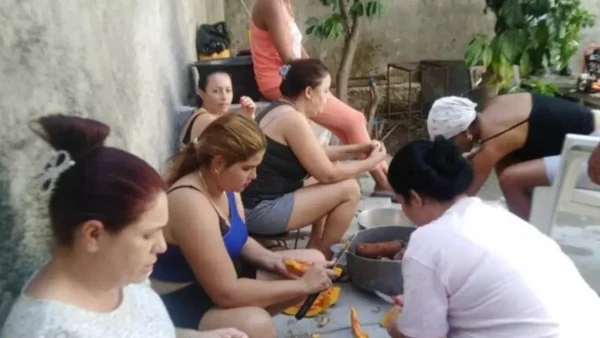Cuban “Mules” Remain Stuck in Haiti Amid Chaos

Havana Has Plans To Repatriate the Cubans Stranded in Haiti but With No Set Date
HAVANA TIMES – After two weeks without a word about the fate of the Cubans trapped in Haiti, the Cuban Embassy in Port-au-Prince announced on Wednesday that the plan for their return has been designed, but there is no scheduled date as long as the Toussaint Louverture airport remains closed, in the midst of the most recent crisis of violence that the country has been experiencing since February 29th.
“The representative of Cubana de Aviación, a member of the Cuban state mission in Haiti, has established telephone and face-to-face contact with the 32 rental houses where most of the Cuban passengers of the canceled flights are staying, reports the diplomatic headquarters. That group includes 260 Cubans in total, mostly “mules” who travel between Haiti and the Island to stock up on goods that are scarce in Cuba.
According to the statement, the Embassy is in contact with Barbara Joseph, the commercial specialist for Sunrise Airways, the Haitian travel company used by the Cubans. “There will be flights to two destinations: Camagüey and Santiago de Cuba. Passengers from other provinces will be transported by Transtur bus to their places of origin,” the text adds.
To organize the return, Cubans who reside in Haiti – mostly workers on Cuban “missions” such as the 60 healthcare workers – and those who are passing through will meet virtually with the representatives of both airlines “in order to provide relevant information and discuss concerns.”
Some family members reflect on the distressing situation of their loved ones. “They have spent over three weeks in a place full of uncertainty, hardship and fear. Shootings and killings in the streets continue; the violence is unimaginable,” says one person.
“I make this appeal to all the families of the Cubans who are stranded in Haiti to raise our voices and ask the Government to do something for them. They have been telling us lies for 23 days, in one statement after another, about how they are going to get them out, and they still haven’t done a thing. We want our families here now! We are desperate. Please help us if you can,” one woman demanded of the Foreign Ministry, while another, whose aunt is in Haiti, wanted a quick return for her. “May God allow everything to go well and soon everyone will be here in Cuba eating together, even if it’s just picadillo, but happy and calm.”
On February 29th, when the armed gangs began a new wave of violence in Haiti, a Sunrise Airways plane bound for Cuba was delayed by gunfire. That day, for security reasons, air traffic was closed, preventing the return of the Cubans who were in the country, who have asked for help from both the airline and the Cuban Government. There are another 2,000 Cubans in Haiti “in different conditions,” according to the Minister of Foreign Affairs, Bruno Rodríguez, last week on Cuban television.
At the moment, the only country that has begun to evacuate its nationals is the United States, which plans to take 30 people every day by helicopter to the Dominican Republic. According to CNN, another 30 people were transferred to Miami on a flight chartered by the State Department. In total, there are almost 1,000 Americans in Haiti, said its spokesman, Vedant Patel.
In the meantime, the situation in the capital remains high-risk. This Wednesday, the streets of Pétion-Ville, in the hills of Port-au-Prince, were again strewn with bodies. This neighborhood is the only one in the capital of Haiti that is not yet completely controlled by armed gangs.
Seven bodies were found, adding to the 15 found two days earlier. The images were similar: bodies shot – some in the midst of flames and others already charred – stretchers with the deceased being put into ambulances and workers carrying coffins.
In addition to the already existing insecurity, at the beginning of the month about 3,000 prisoners, including gang leaders and members, managed to escape from two prisons in the city, during assaults by armed groups.
All this has an impact on the functioning of the city. There is practically no commercial activity, schools are closed, and there is a constant movement of people fleeing from their homes and neighborhoods to areas considered safer.
According to the latest data from the International Organization for Migration (IOM), this new escalation of violence has led to more than 15,000 people becoming displaced. In total, more than 86,000 Haitians live in 84 refugee centers, in schools, churches and public squares, where they survive in unhealthy and inhumane conditions. In addition, according to IOM, in less than a week, 17,000 people left the capital in search of a safer place and traveled with family and friends to other provinces, putting themselves in danger, since the gangs control the roads.
The United Nations agency estimates that, since the beginning of the year, in the metropolitan area of Port-au-Prince, the displaced population has increased by 15%, and 160,000 people cannot return to their homes.
All this happens while waiting for the implementation of a transitional presidential council. The Haitian Prime Minister, Ariel Henry, will then leave power, and a multinational security force will be deployed, led by Kenya.
Translated by Regina Anavy for Translating Cuba

This is not a good system it much better and cheaper to just ship a container by boat . The cuban gov needs to clean up the delays and excess tariffs and stop items from going missing at all air ground and sea terminals. The airline should have pay for and supply transportation and a safe place to stay untill they provide flights in my opinion